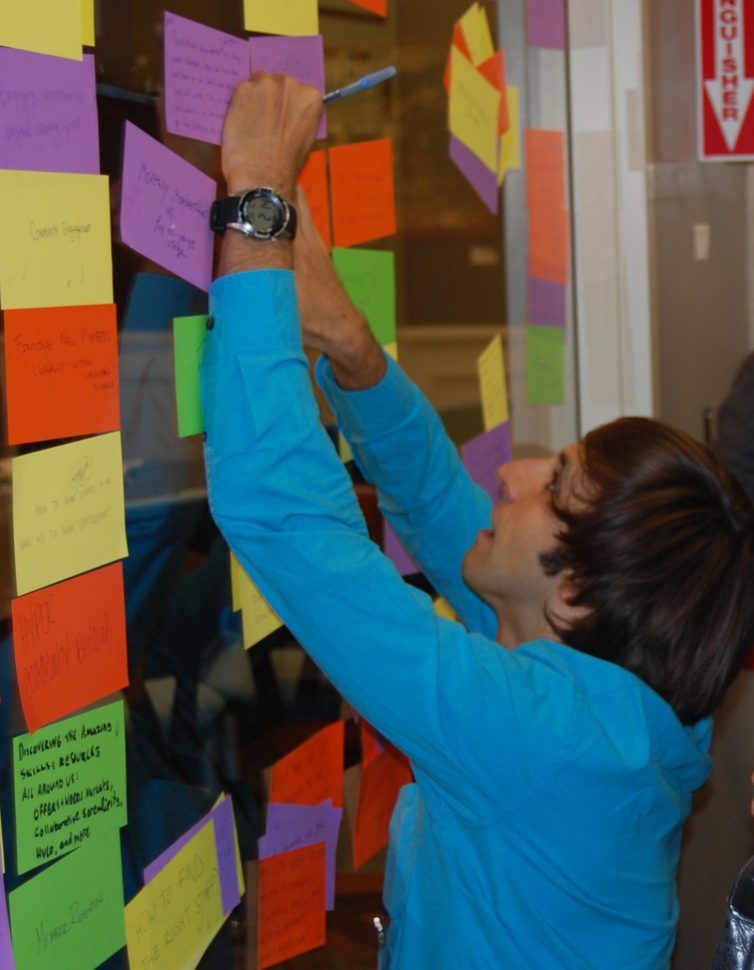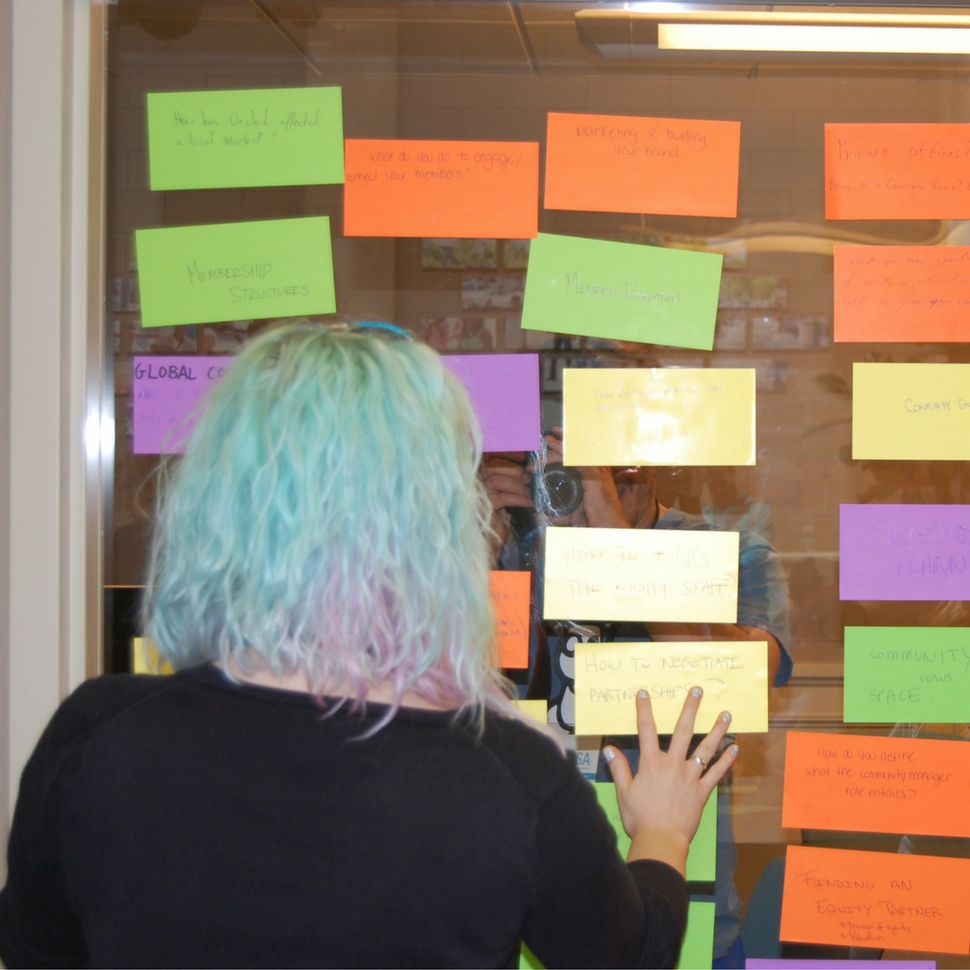If you’re thinking of hosting a conference, consider an unconference instead. If you’re not familiar with Unconferences, it’s a conference where attendees determine the programming; offering a refreshing twist on the traditional conference model.
I spoke with coworking veteran and thought-leader Tony Bacigalupo from New Work Cities to get the inside scoop on hosting a successful unconference. Bacigalupo ran the first designated coworking space in New York City and has facilitated countless unconferences. Here’s what he had to say.
Cat Johnson: Let’s start with a big picture question. What do you like about the unconference model?
There are a few key advantages to an unconference. Two of the most powerful ones are the fact that the people who attend get to decide what happens and what gets talked about. As such, it becomes easier to ensure that the topics people want to talk about get talked about and no major things get missed.
One of the problems you’ll see with a traditional conference is that there’s a bit of a guessing game involved in figuring out what kind of programming to create. If something happens in the news, or if there’s a major announcement or development within a few weeks of your conference, everyone’s going to want to talk about it. But, it’s going to be either very stressful or impossible for you to accommodate that in a traditional pre-planned format.
The other thing is that an unconference cultivates a sense of participation and shared investment among the attendees who are now active participants. At a typical conference, you might have a lot of people in the audience who might be just as good or better than the people on stage. You’ve now leveled the playing field and allowed for some of those voices to be heard.
What preparation and supplies are needed to host an unconference?
Start with the venue. You need to be able to convene everybody in one space where you can explain the process and how the unconference works. Then, you need breakout rooms. Depending on the size of the crowd, you’re going to want at least four separate areas where people can have a conversation without bothering the other ‘groups’. Though it can be done in a large auditorium space where you split up the room, I recommend having separate enclosed, classroom spaces.
As for supplies, you need tape, paper, Slickynotes or large Post-it notes, lots of pens so everyone can write simultaneously, and basic amenities like coffee and snacks that are out and available to share.
You’ll want signage at the venue to direct people to the different rooms and to let people know where the unconference is. You won’t need much beyond that.
How do you introduce the unconference idea, both beforehand and at the event?
If people aren’t used to the idea, I suggest pairing the unconference with some pre-arranged programming. You can have a number of programmed talks, or a separate day of talks, but, in general, you want to explain that people get to determine the programming.
Once you have a wall full of ideas, how do you start the organizing process? With overlap and loosely related ideas, how do you manage to group and surface themes?
Be very careful with the initial process of educating people. Talking them through it step-by-step is critical because once you open it up to the public it will become chaotic and you want to make sure it’s a managed chaos and that you’ve thought things through so you don’t have any major disasters.
Give people time to ask questions and make it clear this is not a time or place for pitching your own idea. Everyone involved must be deputized to prevent people from turning it into a pitch for their products so that, if someone does, they’ll be admonished. And ultimately, if a session is not going the way people would like it to, they should use the law of two feet—you have two feet, use them—to get up and leave. People should feel empowered to do that.
In terms of the selection process, there is a little bit of magic to it. People offer votes by adding a checkmark to the talks they’d like to participate in. If there are four timeslots, people get four checkmarks. If there are eight, they get eight checkmarks.

After people vote, it’s time to arrange the talks to see which ones are common themes that can be consolidated and which ones stand out as individual talks. Start with the big topics that got the most votes or topics that can easily be consolidated; make sure these aren’t held at the time time.
For the rest of them, use your judgement. Take a combination of the votes a topic has received and your own judgement. It doesn’t need to be a perfect process, it doesn’t need to be one hundred percent ascribed to the votes. Use your judgement to find the most valuable, most relevant topics that will stand out and provide the most value to attendees.
Ultimately, no unconference is perfect, but for the most part, people seem to enjoy them and leave happy.
Do you have any other tips about organizing the tracks and times?
Be flexible, allow for things to change. You may have to suddenly change the time slot if something changes at the last minute.
Give yourself and attendees at least 15 minutes between panels. The panels will run overtime. Go around and give people a five-minute warning and go around and tell people when they need to wrap it up.
Do the sessions usually take care of themselves, in terms of getting conversations going? Do you do any explaining or facilitating of that?
The quality of the discussions is entirely related to the culture of the people there and the extent to which they are accustomed to this kind of format. It generally does work out, but if you’re dealing with a crowd that is used to typical conferences and is not as comfortable with this new way of relating, I highly recommend having volunteer facilitators who are experienced with unconferences or at least experienced with facilitating a group conversation.
One of the newer models I’m playing with is shifting the purpose away from just an open-ended conversation around a topic and toward more of a working-group format where the topic is a question and everyone works on brainstorming answers to the question. This creates a sense that it’s not just people lecturing, but it’s everyone collaborating.
Sometimes, one or two people dominate conversations. There’s not necessarily anything wrong with one person doing most of the talking, but perhaps shifting the intention to being more democratic would help more voices get heard.
Make sure every session has a dedicated note-taker. That way, there’s at least one person from each session who has a record of what was said.
What do you suggest doing to wrap-up an unconference?
Create time for people to reconvene at end of the day to share what they’ve learned.
Photos taken by Cat Johnson


 Dr. Gleb Tsipursky – The Office Whisperer
Dr. Gleb Tsipursky – The Office Whisperer Nirit Cohen – WorkFutures
Nirit Cohen – WorkFutures Angela Howard – Culture Expert
Angela Howard – Culture Expert Drew Jones – Design & Innovation
Drew Jones – Design & Innovation Jonathan Price – CRE & Flex Expert
Jonathan Price – CRE & Flex Expert













